Princeton
When Europeans first arrived in what is now New Jersey, they travelled along trails created by the Lenni Lenape Indians. These trails became highways for settlers and in 1683 New Englander Henry Greenland built a house and tavern on one of these highways. Although the location of his tavern was northwest of the centre of modern day Princeton, he was the first settler within the current city boundaries. Around 1685 Daniel Brinson, Greenland's son-in-law, settled beside the highway just west of the centre of Princeton. Quaker families settled in the area in the 1690s. Exactly when Princeton was founded is unclear, but it is first mentioned in 1724 and it is thought that the town was named after King William III of England, otherwise known as Prince William of Orange. In 1756 the College of New Jersey moved from Newark to the village of Princeton where it built Nassau Hall. In 1777 George Washington’s Continental Army defeated the British at the Battle of Princeton, which was seen as a turning point in the Revolutionary War. After the Revolutionary War Princeton grew, initially because it was on the New York to Philadelphia Highway then from the 1830s the Delaware & Raritan Canal and the Camden & Amboy Railroad brought more growth. The University grew and in 1896 the college officially became Princeton University. Modern Princeton is a bustling university city with a population close to 30,000 people.
Nassau Hall, Princeton University
The College of New Jersey received its charter in 1746, the fourth college in the British North American Colonies. It was originally located in the Reverend Jonathan Dickinson's parlor in the town of Elizabeth, which is nowadays just south of Newark International Airport. It started with just 10 male students. After a year it moved to Newark then in 1756 it moved to Princeton. In Princeton, Nassau Hall was built on land donated by Nathaniel FitzRandolph. Like Princeton, the name of the hall derives from King William III, who was Prince of Orange, a branch of the House of Nassau. Nassau Hall was one of the largest building in the Colonies and it housed the entire College including dormitories for nearly half a century. The Hall was occupied by both sides during the Revolutionary War and it still bears a scar from a cannonball that hit it during the Battle of Princeton. From June to November in 1783 the Continental Congress met in Nassau Hall, making it for that time the capitol of the United States. During this session, Congress received news of the signing of the Treaty of Paris, which marked the official end of the Revolutionary War. In 1802 fire gutted the hall, leaving only the walls standing and just 100 books in the library unburned. Nassau Hall was rebuilt only to burn again in 1855. The cupola was added during the reconstruction after the second fire.
Alexander Hall, Princeton University
Every university needs an assembly hall and Princeton’s of a very memorable design. Architect William Appleton Potter designed Alexander Hall in the Richardsonian Romanesque style known for its round topped arches, cylindrical towers and varied colours and textures of stonework. It was built with money donated by Harriet Crocker Alexander whose husband, his father and his grandfather all had links to the college. Work on the hall commenced in 1892 and it opened in 1894. In addition to being used as an assembly hall it is also the home of Princeton University Orchestra and the Princeton Symphony Orchestra
Home > US States > Midatlantic USA > New Jersey >
Click on Minimap to navigate
Blair Arch, Princeton University
At the point where Blair Hall meets Buyers Hall stands the Blair Arch. When Blair Hall was built in 1897 it stood on the western boundary of the campus, so architects Cope and Stewardson designed an arch in the Collegiate Gothic style to create an entrance to the campus. The arch served as a gateway to the University for passengers disembarking from the train into town. The arch was named after John Insley Blair who was a trustee of Princeton from 1866 to 1899. An unplanned aspect of the design of the arch is its outstanding acoustics, as a result of which it is used for singing performances, for example by student a cappella groups.
DLU170420


To move forwards or backwards through the New Jersey trail click the arrows above, or select your next destination on the Minimap.
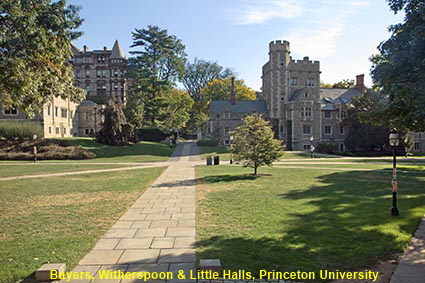
Buyers, Witherspoon & Little Halls, Princeton University
Despite Nassau Hall burning down twice, the College of New Jersey went from strength ot strength. In 1896, the college achieved University status and was officially renamed Princeton University. In 1902 Woodrow Wilson became the 13th president of the University and he embarked on a programme to expand it and to improve the quality of teaching. He proposed that the University be structured as a number of colleges where students would reside along with resident faculty masters. Wilson left Princeton in 1910 to focus on a political career that would culminate in him becoming the 28th US President and his plan for colleges did not come to pass until 1983. The university now has six residential colleges, Buyers and Witherspoon Halls are part of Rockefeller College. From 1932 to 1955 Albert Einstein was based at Princeton University. The University can claim several former Presidents and former First Lady Michele Obama as graduates.
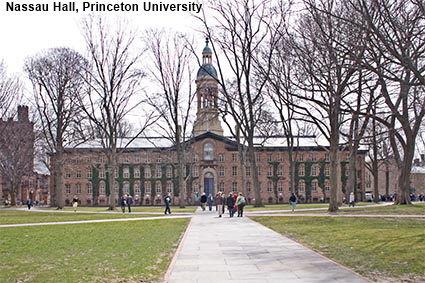
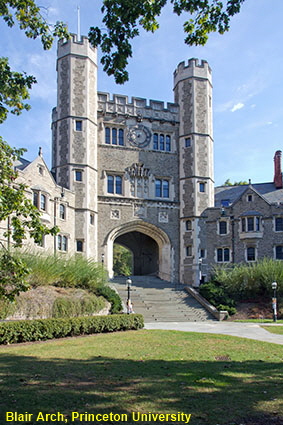
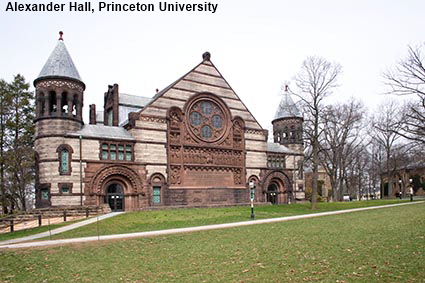
Bainbridge House, 158 Nassau Street
Bainbridge House was built in 1766 by Job Stockton and hence is one of the oldest buildings standing in Princeton. Why isn’t it called Stockton House? The reason is that on May 7, 1774 William Bainbridge was born in the house. Bainbridge joined the early US Navy and he was captain of the USS Constitution during the War of 1812 against Britain. On 29 December 1812 while sailing off the coast of Brazil the USS Constitution engaged with HMS Java. The crew of HMS Java was inexperienced with little training in gunnery, while the USS Constitution had a crack crew. HMS Java was seriously damaged and forced to surrender. Bainbridge was wounded twice during the action. For achieving a victory against the might of the British Navy, Bainbridge was awarded the Congressional Gold Medal. His fame ensured that his birthplace bears his name rather than the name of its builder. In 1877 the house was bought by Princeton University and for over 50 years it housed Princeton Public Library. From 1967 through to 2015 Bainbridge House was occupied by the Historical Society of Princeton. At the time of writing, the University had engaged architects to plan the preservation and renovation of the building.
Nassau Inn, Palmer Square
Judge Thomas Leonard was instrumental in persuading the College of New Jersey to move from Newark to Princeton. In 1756, the year that the college moved to Princeton, Leonard built a home in Nassau Street but he did not enjoy his new home for long as he died in 1759. The house was sold to Christopher Beekman who turned it into a hostelry called the College Inn. It became a very popular tavern and because of its location on the King’s Highway between New York and Philadelphia it was also a popular place to stay. In 1776 several of those who signed the Declaration of Independence stayed at the inn on their way to the first Continental Congress in Philadelphia. As the 19th century arrived, Beekman retired and John Gifford took over, changing the name to Nassau Inn. The inn that Beekman founded lasted until 1937, by which time it had become outdated. The old Nassau Inn was demolished and the site became a garden in the middle of Palmer Square known for its tiger statue. A new Nassau Inn was built further back from Nassau Street as part of a major redevelopment that created Palmer Square. The Nassau Inn is the only full service hotel close to Princeton University which ensures that it is always busy.
Thomas Clarke House, Princeton Battlefield
Fighting in the Revolutionary War was a seasonal activity, the harsh US winters ensured that both sides retired to winter quarters during the worst of the weather. After several defeats in New York, the Continental Army commanded by George Washington won a small battle at Trenton in late December 1776. With morale suddenly boosted, Washington decided to try to take on the British again before heading to winter quarters. The Continental Army attacked the British in the open fields of Thomas Clarke’s farm outside Princeton on January 3, 1777. Initially it did not go well for the Americans and they started fleeing towards Thomas Clarke’s house. Washington rode up with reinforcements, which rallied American morale and eventually the British retreated. The Continent Army then pushed into the centre of Princeton where some British troops were barricaded in Nassau Hall. They surrendered after cannonballs were fired into the hall. The farmhouse around which the battle raged was built in 1772. It survived the battle and was extended in the 1840s. The Thomas Clarke House has been restored and is open to the public. The original west wing is furnished as it would have been at the time of the battle while the newer east wing houses an exhibition on the battle.
Rockingham State Historic Site
To the north east of Princeton, is a house that partly dates back to 1710. The original house was just a two storey, two room house with a lean-to at the back. The house and surrounding land was bought by John Berrien in 1735. Berrien’s first wife Mary died childless in 1758 but he and his second wife Margaret Eaton had six children. They enlarged the house to provide room for their growing family. Berrien drowned in 1772 leaving the house and land to his wife. In 1783 the house was George Washington's last Revolutionary War headquarters. The Continental Congress was meeting in Nassau Hall during the Paris negotiations to end the war. General George Washington was invited to Princeton, but there was nowhere suitable for him to stay in town. Margaret Berrien had advertised Rockingham for sale (the first record of its name), and was living in Princeton. Washington and his entourage rented the house, staying for over 2 months. While here Washington received news that the Treaty of Paris had ended the war. He then wrote his Farewell Orders to the Armies of the United States and announced his retirement from the army. In 1802 Frederick Cruser bought the house and extended it. In the 1890s the house was bought by a quarry company, and was moved several times to avoid quarrying activities. The house is now operated by the State of New Jersey as Rockingham State Historic Site. Click Tab 2 to see a picture of the interior of the house. The house was closed so it was taken through a window.
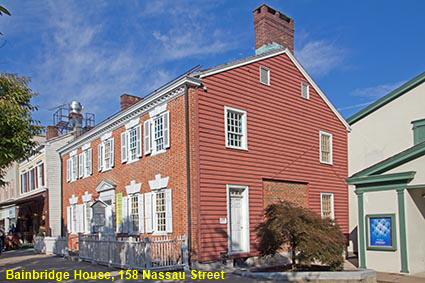
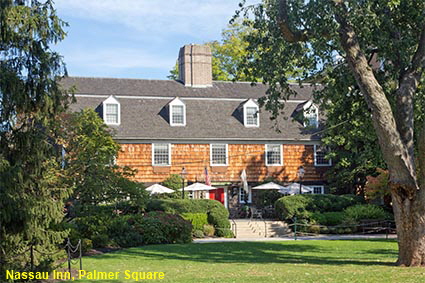
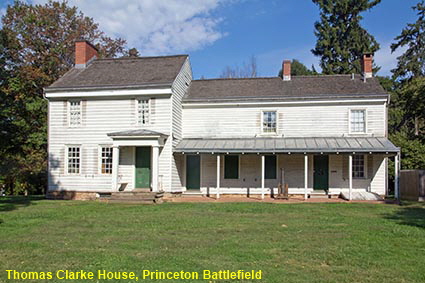
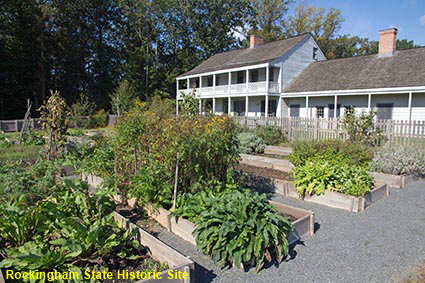
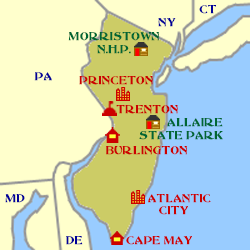
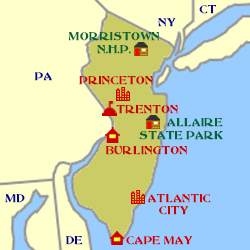
© Mike Elsden 1981 - 2025
The contents of this page may not be reproduced in full or in part without permission